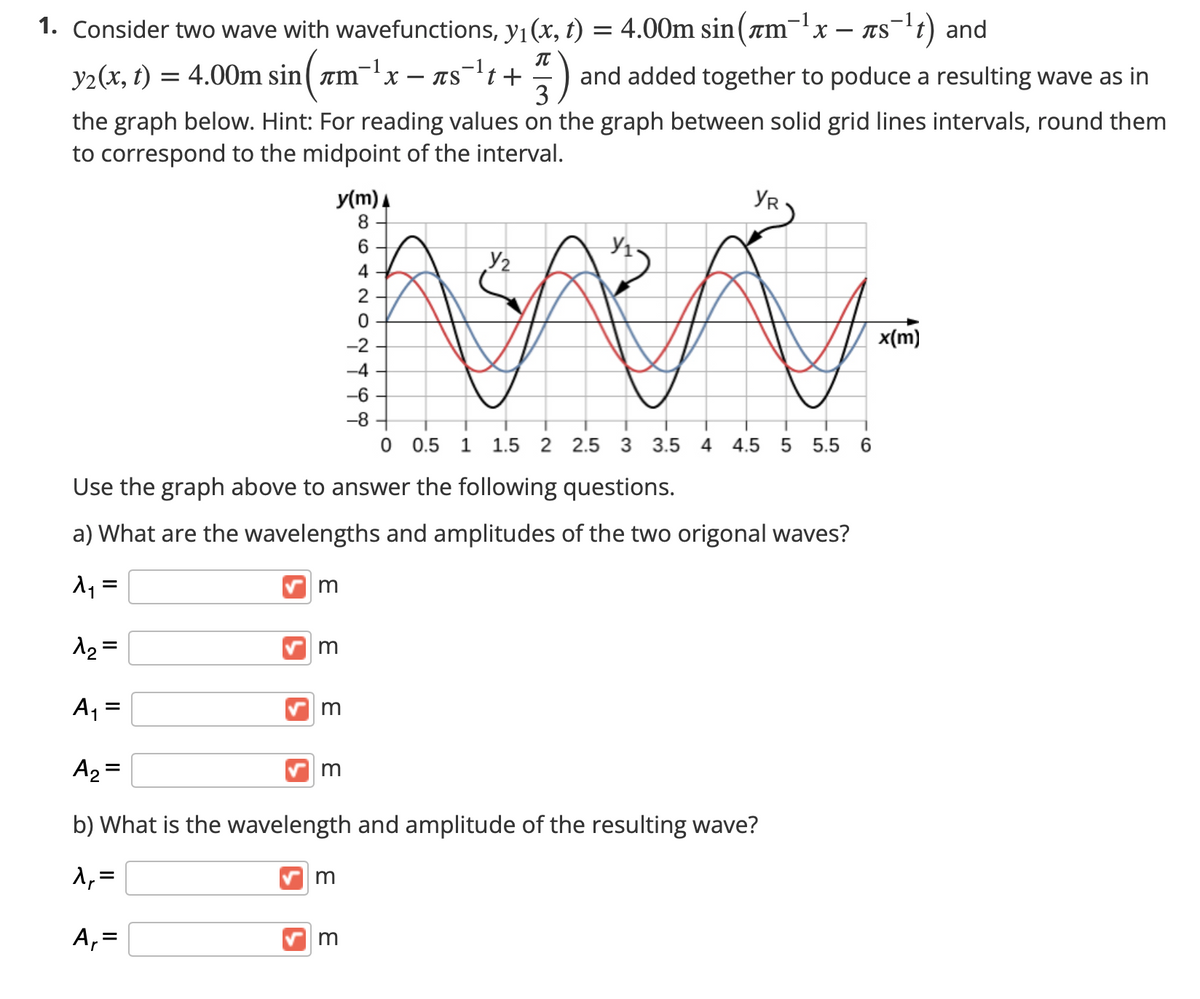1. Consider two wave with wavefunctions, y1(x, t) = 4.00m sin(am¯1x – as-'t) and y2(x, t) = 4.00m sin( am-lx – S %3D X - – Ts-lt+ and added together to poduce a resulting wave as in 3 the graph below. Hint: For reading values on the graph between solid grid lines intervals, round them to correspond to the midpoint of the interval. y(m) 4 8 - YR 4 2 -2 x(m) --4 -6 -8 0 0.5 1 1.5 2 2.5 3 3.5 4 4.5 5 5.5 6 Use the graph above to answer the following questions. a) What are the wavelengths and amplitudes of the two origonal waves? 1 = 12 = A1 = A2 = b) What is the wavelength and amplitude of the resulting wave? 1,= A,=
1. Consider two wave with wavefunctions, y1(x, t) = 4.00m sin(am¯1x – as-'t) and y2(x, t) = 4.00m sin( am-lx – S %3D X - – Ts-lt+ and added together to poduce a resulting wave as in 3 the graph below. Hint: For reading values on the graph between solid grid lines intervals, round them to correspond to the midpoint of the interval. y(m) 4 8 - YR 4 2 -2 x(m) --4 -6 -8 0 0.5 1 1.5 2 2.5 3 3.5 4 4.5 5 5.5 6 Use the graph above to answer the following questions. a) What are the wavelengths and amplitudes of the two origonal waves? 1 = 12 = A1 = A2 = b) What is the wavelength and amplitude of the resulting wave? 1,= A,=
University Physics Volume 1
18th Edition
ISBN:9781938168277
Author:William Moebs, Samuel J. Ling, Jeff Sanny
Publisher:William Moebs, Samuel J. Ling, Jeff Sanny
Chapter16: Waves
Section: Chapter Questions
Problem 101P: Consider two wave functions that differ only by a phase shift, y1(x,t)=Acos(kxt) and...
Related questions
Concept explainers
Interference of sound
Seiche
A seiche is an oscillating standing wave in a body of water. The term seiche pronounced saysh) can be understood by the sloshing of water back and forth in a swimming pool. The same phenomenon happens on a much larger scale in vast bodies of water including bays and lakes. A seizure can happen in any enclosed or semi-enclosed body of water.
Question

Transcribed Image Text:-1
1. Consider two wave with wavefunctions, yı(x, t) = 4.00m sin(am¯'x – Tst) and
-1
= 4.00m sin( rm
-1
TSt +
IT
and added together to poduce a resulting wave as in
3
y2(x, t)
x,
the graph below. Hint: For reading values on the graph between solid grid lines intervals, round them
to correspond to the midpoint of the interval.
y(m) 4
8.
YR
6.
Y2
4
2
-2
x(m)
-4
-6
-8
0.5
1.5
2 2.5
3 3.5 4
4.5
5 5.5 6
Use the graph above to answer the following questions.
a) What are the wavelengths and amplitudes of the two origonal waves?
=
m
A2 =
A2 =
m
b) What is the wavelength and amplitude of the resulting wave?
1,=
m
A,=
m
Expert Solution
This question has been solved!
Explore an expertly crafted, step-by-step solution for a thorough understanding of key concepts.
Step by step
Solved in 2 steps with 3 images

Knowledge Booster
Learn more about
Need a deep-dive on the concept behind this application? Look no further. Learn more about this topic, physics and related others by exploring similar questions and additional content below.Recommended textbooks for you

University Physics Volume 1
Physics
ISBN:
9781938168277
Author:
William Moebs, Samuel J. Ling, Jeff Sanny
Publisher:
OpenStax - Rice University

Physics for Scientists and Engineers with Modern …
Physics
ISBN:
9781337553292
Author:
Raymond A. Serway, John W. Jewett
Publisher:
Cengage Learning

Physics for Scientists and Engineers
Physics
ISBN:
9781337553278
Author:
Raymond A. Serway, John W. Jewett
Publisher:
Cengage Learning

University Physics Volume 1
Physics
ISBN:
9781938168277
Author:
William Moebs, Samuel J. Ling, Jeff Sanny
Publisher:
OpenStax - Rice University

Physics for Scientists and Engineers with Modern …
Physics
ISBN:
9781337553292
Author:
Raymond A. Serway, John W. Jewett
Publisher:
Cengage Learning

Physics for Scientists and Engineers
Physics
ISBN:
9781337553278
Author:
Raymond A. Serway, John W. Jewett
Publisher:
Cengage Learning

Principles of Physics: A Calculus-Based Text
Physics
ISBN:
9781133104261
Author:
Raymond A. Serway, John W. Jewett
Publisher:
Cengage Learning

Physics for Scientists and Engineers, Technology …
Physics
ISBN:
9781305116399
Author:
Raymond A. Serway, John W. Jewett
Publisher:
Cengage Learning
